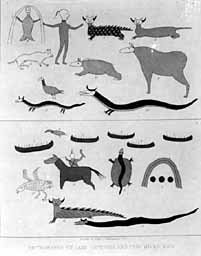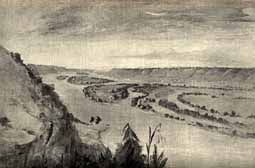

 |
 |
As soon as the canoe was fastened to the shore, I told L'Amirant to shoulder the sack, and away we trudged with it to the agent's house, to which the name of Helena had been given, where I delivered my charge and took a receipt. Mr. Whitney's nephew and his wife received me civilly, and insisted upon entertaining me with breakfast, which when I had despatched, I went to see what they called the shot-tower, where lead brought from the lead district of Wisconsin, not many miles off, is cast into shot of various sizes. This shot-tower was not one of the ordinary columns, that rise to a great height from the surface, but was a cylindrical excavation, ingeniously made in an escarpment of the incoherent sandstone, 200 feet in height. The lead was melted at the top, and afterwards poured down to a chamber below. The whole contrivance did great credit to the projector. From the top of the escarpment I had an extensive view of the Wisconsin, with the broad bottoms of fertile soil on each side of it, forming altogether a rich valley, about two miles in breadth, once entirely occupied by this flood, in the ancient state of the river, and which had contracted itself into its present channel, either upon that last retreat of the waters of the country which I have before alluded to, or from its diminution by the gradual drainage of the country. ...
... Mr. Whitney's agent informed me that galena was found within twenty
miles of the shot-tower, and in examining some of the highest
parts of the escarpment, I found a sparry calcareous rock, resembling
that in which the galena is found in the state of Missouri, a
fact which led to the inference that the galena of this district
might also be inclosed in equivalent strata. I left
Helena at 11 A.M. The morning
was beautiful, and having made a good
breakfast, I went gliding on and enjoying the scenery. Near
1 P.M. we came up with a mass of sandstone which had fallen off
from an escarpment, about thirty feet in height, for about 200
feet in length; the water had underworn it, and being loose and
incoherent, it had peeled off, leaving a smooth face. About
2 P.M. we stopped at a little cove to let the men dine, at a place
where I found what I had not met with before, an industrious
family, in a clean wigwam. There were two male Indians, and two
women, with three male children, the males being all naked except
their breech-clouts. The men were at work weaving matting, and
the women were making mocassins. Some corn was boiling in a pot,
and some venison was roasting on a stick. They offered us money
for some biscuit, and were evidently familiar with the ways of
white people, being in the habit of frequenting
Prairie du Chien, on the
Mississippi. As we were approaching this place, where
we could replenish our stores, I gave them a liberal supply of
biscuit, and in return they presented my people with a very dirty
thin piece of venison.

About half-past 2 P.M. we were afloat again, and soon passed a fine stream coming in from the right bank. The country here was remarkably beautiful, the slopes of the banks gracefully wooded, and occasionally interrupted by coves. For a distance of about three miles the escarpments were about 250 feet high, the rock every now and then jutting out and taking a castellated appearance. ... I observed, too, that the incoherent structure of the sandstone had been favourable to Indian talent, the figures of deer, men, and horses--sometimes well executed--being cut in it, and sometimes painted with a red bole. The swallows had availed themselves of the softness of the rock by picking holes in it, and building their nests there in innumerable quantities. ... About 6 P.M. we stopped for the night at a bold bank, up which the men had to carry the butin to a commodious encampment.
August 31.--On peeping out from my tent at 5 A.M., I perceived we were in the midst of a dense fog, and that the high grass was bent with the heavy dew; we, however, launched the canoe, and crept slowly along by compass until near seven, when the fog gradually rose, and again disclosed the beautiful shores of the Wisconsin. Soon after we reached Prairie de la Baie, where the scene was very pleasing, there being a fine level prairie to the south, terminating about a mile and a half from the river in gracefully rounded hills; whilst close to the edge of the shore were several Indian lodges, with the smoke rising from them; the departing fog, in the distance, creeping in a gauze-like substance along the banks of the hills. The river here was studded with charming little islands; on our right the hills came down close to the water, and we had a beautiful cloudless morning, smiling on the most placid of streams. The picture presented one of the finest subjects for a landscape-painter, and I was tempted to stop a moment to enter a slight sketch of it in my portfolio. About half-past nine we stopped at the Rivière Bleu to breakfast. ...
Having made a hearty breakfast we got afloat again, and about 1 P.M. observed a small prairie on the right bank with some Indian mounds: they reminded me of the lesson I got in Lake Huron, when violating the deserted tombs upon the small island, and I was far from offering any disrespect to these. About 2 P.M. the river began to widen, and we were rapidly approaching the point of its confluence with the Mississippi. I could already perceive the lofty right bank of that famous stream at the end of the vista; and being desirous of letting the men dine, and of taking a sketch of the confluence of these two noble rivers, I landed for an hour. At half-past 3 P.M. we bade adieu to the charming Wisconsin, and to the enjoyment of floating upon a favourable current, having entered upon the broad surface of the Mississippi, where our course was changed to north-north-west, and all our force was wanted to contend against the force of the descending stream. The river appeared at this point to be about 900 yards across; its waters were clearer than those of the Wisconsin, having deposited much of their sedimentary matter during their long course, a great part of which is through primary rocks. We soon came in sight of Prairie du Chien, an extensive level bottom or prairie, closed in to the east by a strong rocky bluff, which was no doubt once the bank of the river. A new scene now presented itself; there was a respectable-looking military post, cattle grazing, a village, and evidences of a settled population, to which I had been for some time a stranger.
 Prairie du Chien |
 Ft Crawford |